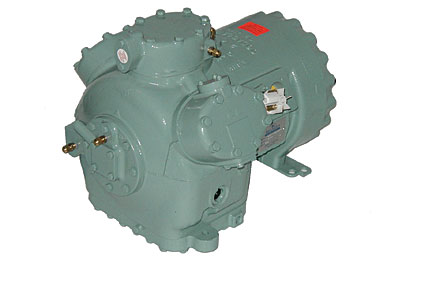
|
| Photo courtesy of Brainerd Compressors. |
Although I’ve never written anything about the company, is an important part of our business because it still rebuilds large, serviceable hermetic compressors. This is a dying art and business because welded hermetic scroll compressors now dominate that portion of the market.
Back when I first started servicing and teaching (some 40 years ago), compressors, in particular, were quite different than today. They weren’t nearly as reliable as they are now and were not anywhere near as efficient. The old piston-type compressors were very vulnerable to damage from refrigerant foaming and floodback since this would easily blow out the pistons and valves.
To minimize such damage, manufacturers allowed a lot of clearance between the top position of the piston and the valves. This provided a place for any extra liquid refrigerant to hide. However, during each cycle this also left some already compressed gas to re-expand on the downstroke, only to be compressed over again. This resulted in efficiency losses.
Although the common explanation for such waste is that energy was “cheap” back then, it was still pretty costly. However, it was worth the cost of a little extra energy to make sure compressors had a long life.
It was sometime in the mid-1980s when I saw my first scroll compressor come down the assembly line at the Carrier residential air-conditioning plant in Collierville, Tenn., where I was teaching a class. These compressors were Japanese made, and I suspect no one outside the plant was told of the change because it was indeed an experiment. Those Japanese scrolls were pretty pricey.
A couple years later, I went to the Copeland plant in Ohio to write a story about its new “compliant” scroll compressors. It was probably the first such story to be written in terms contractors could easily understand, to explain why – with their low internal clearances and no piston to damage the valves – scrolls were the thing of the future. Thereafter, sales started to skyrocket. Then, when the government set 10-SEER as the minimum air-conditioning efficiency, all that most manufacturers had to do in order to meet the requirements was install scroll compressors on their new models.
Scrolls (and now rotary compressors) have changed our industry a lot. Not only are air-conditioning and refrigerating units a lot more efficient, but failures have been reduced manyfold. As a result, most manufacturers confidently offer much longer warranties on their equipment.
Where will we go from there? It will be interesting to see what happens in the future as the government continues to meddle in our business. Its legislation has resulted in significant increases in the wholesale and retail prices of new equipment.
Although staged and variable compressors will help to raise efficiencies in the future, science may eventually be able to come up with more efficient solid-state thermocouple systems that will bring an end to our need for compressors. These would, of course, not require any refrigerant. But then, who knows?
HELPFUL LINKS:
- Contact Supply House Times
- Follow Supply House Times on Twitter!
- Find Supply House Times on Facebook!



